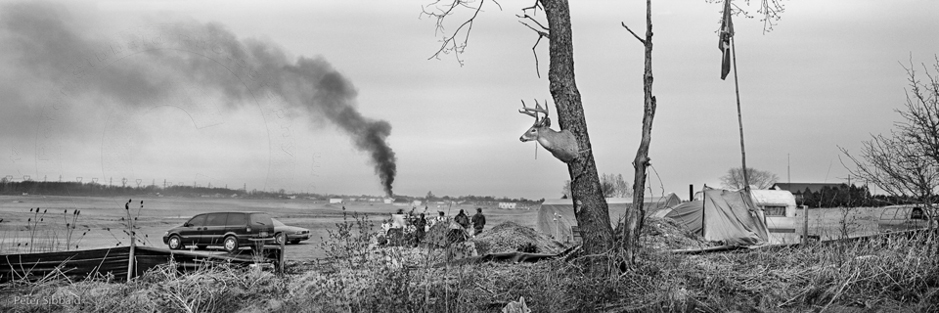Six Nations Mohawk Protest/ Haudenosaunee Land Reclamation Site

Caledonia, Ontario. Six Nations Protest/ Haudenosaunee Land Reclamation Approx. 43° 3’19.09″N 79°58’8.98″W, N of 6th Line, W off Argyle St., facing NW, April 20, 2006
Six Nations (the Haudenosaunee people) occupiers watch smoke rise from a wooden bridge allegedly burned by protestors in reaction to an Ontario Provincial Police raid earlier that day as they attempted to break a 7 week-old occupation of a 40-hectare housing development site called the Douglas Creek Estates.
Many First Peoples carry long memories and are acutely more aware of their history than non-Natives. On Canada’s largest Native reserve, the Six Nations, in 1924 under the ever-contentious Indian Act, the government of Canada forcibly removed and outlawed the traditional council and installed a friendly band council and chief destining the members of that community to internal feuding until this very day. In the ensuing 24-hours, with the then ongoing Ipperwash Inquiry into the OPP’s fatal shooting of Kettle Point First Nations member Dudley George in the near background, history is made when Six Nation band leadership accedes speaking rights to the traditional leadership, reuniting the community and obliging Canada and Ontario to begin negotiating with a hereditary traditional leadership that governments had circumvented for eight decades. At stake is not just the disputed 40 hectares outside Caledonia, but the entire Haldimand Proclamation, a 385,000-hectare tract 10 kilometres either side of the entire length of the Grand River, which the Haudenosaunee argue was stolen and of which they view this site as but a test.
By mid-2009 this land dispute remains un-resolved, the land still occupied by the Haudenosaunee.
